| Basic Specifications | |
|---|---|
| Full model name: | Canon EOS Rebel SL1 (EOS 100D) |
| Resolution: | 18.00 Megapixels |
| Sensor size: | APS-C (22.3mm x 14.9mm) |
| Kit Lens: |
3.06x zoom
18-55mm (29-88mm eq.) |
| Viewfinder: | Optical / LCD |
| Native ISO: | 100 - 12,800 |
| Extended ISO: | 100 - 25,600 |
| Shutter: | 1/4000 - 30 sec |
| Max Aperture: | 3.5 (kit lens) |
| Dimensions: |
4.6 x 3.6 x 2.7 in. (117 x 91 x 69 mm) |
| Weight: |
22.0 oz
(623 g)
includes batteries, kit lens |
| Availability: | 04/2013 |
| Manufacturer: | Canon |
| Full specs: | Canon SL1 specifications |
SL1 Summary
The Canon SL1 is the smallest and lightest DSLR that we've ever reviewed, delivering DSLR performance and image quality in a body that's almost as small as today's mirrorless camera models. Its features and image quality rival those of its bigger siblings, the Canon Rebel T4i and T5i. But it's not just a miniaturized version of those DSLRs; it's actually better in some ways, most notably its autofocus speed and video skills.
ProsExtremely compact and lightweight for a DSLR; Delivers good image quality that's virtually identical to the Canon T4i/T5i; Accurate and relatively fast autofocus with improved Live View and Movie Hybrid CMOS II AF; Full 1080p HD movie recording; Better-than average kit lens (EF-S 18-55mm f/3.5-5.6 IS STM).
ConsStill not as compact as most mirrorless cameras; Slightly worse than average dynamic range and high ISO performance; Poor battery life.
Price and availabilityAvailable since April 2013 in the U.S. market, the Canon SL1's list price is US$650 body only and US$800 in a kit with the EF-S 18-55mm f/3.5-5.6 IS STM lens. The kit is now readily available in stores and online for US$750.
Imaging Resource rating4.0 out of 5.0
-
Amazing Capture
Amazing Capture and Processing Power
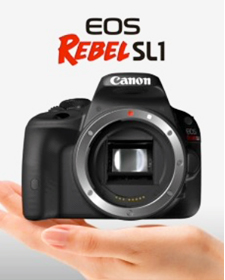
For ultra portability with a minimal footprint, the EOS Rebel SL1 is the world's smallest and lightest Digital SLR camera*. Roughly28% smaller and 25% lighter than the T4i, the EOS Rebel SL1 weighs in at barely over 13 ounces. As small as it is, though, there's no compromise: With an 18.0 Megapixel CMOS (APS-C) sensor, the speedy DIGIC 5 Image Processor, a wide ISO range for both stills and video, and advanced AF performance, it's everything you've come to expect from an EOS camera - just smaller. Designed for entry-level DSLR users, the EOS Rebel SL1 packs more features and fun into the smallest EOS ever.
*Among Digital SLR cameras which use APS-C size equivalent sensors. As of March 1, 2013, based on Canon's research.
This content provided and sponsored by Canon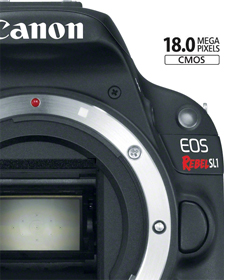
The EOS Rebel SL1 features a newly-developed Canon 18.0 Megapixel CMOS (Complementary Metal Oxide Semiconductor) sensor in the world's smallest and lightest Digital SLR*. Perfect for enlargements or for cropping detailed portions of the composition, the camera's sensor captures images with exceptional clarity and tonal range. This first-class sensor features many of the same technologies used by professional Canon cameras to maximize each pixel's light-gathering efficiency and has center pixels that aid in the EOS Rebel SL1's accurate AF performance. This APS-C size sensor creates an effective 1.6x field of view (compared to 35mm format).
*Among Digital SLR cameras which use APS-C size equivalent sensors. As of March 1, 2013, based on Canon's research.
This content provided and sponsored by Canon
The EOS Rebel SL1's DIGIC 5 Image Processor works with the camera's CMOS sensor to deliver images with incredible detail in more situations, without the need for artificial light sources. With the power of the DIGIC 5 Image Processor, the EOS Rebel SL1 can achieve higher ISO sensitivity, can shoot up to 4.0 fps continuously and can even perform advanced functions like displaying art filters in real time, new scene modes, lens correction and much more. The camera's brilliant imaging core supercharges every facet of still and moving image capture.
This content provided and sponsored by Canon -
High Speed
Continuous ShootingHigh-speed Continuous Shooting
The EOS Rebel SL1 can shoot up to 4.0 frames per second (fps) for up to approximately 7 consecutive RAW files or approximately 28 full-resolution JPEGs. Shooting at speeds of up to 1/4,000 second, the EOS Rebel SL1 can capture even rapidly unfolding scenes with ease. Speed isn't just for sports; anyone with a squirmy toddler knows that the difference between capturing the perfect moment or missing the mark is a matter of tenths of a second. Whether a fleeting expression, the game's winning goal, or the bride walking down the aisle, the EOS Rebel SL1 delivers the speed and performance to capture your special moments.
This content provided and sponsored by Canon -
Exceptional
Auto-FocusExceptional Auto-Focus Performance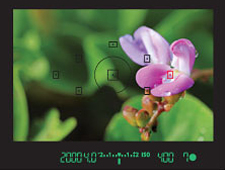
Naturally, you need a top-notch autofocus system to take advantage of a class-leading 18 megapixel sensor, and the EOS Rebel SL1 delivers. When shooting through the viewfinder, the EOS Rebel SL1 offers exceptional autofocus, with a sophisticated 9-point AF system that includes a high-precision cross-type f/2.8 center point for accurate focus whether the camera is oriented in portrait or landscape position. A proven AI Servo AF system achieves and maintains consistent focus for moving subjects, with an exceptional degree of reliability.
This content provided and sponsored by Canon
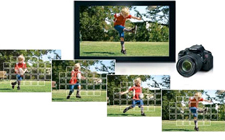
Canon's amazing Hybrid CMOS AF System reaches a new level of capability in the Canon EOS Rebel SL1, providing a perfect solution for shooting both photos and video in Live View. By integrating phase-detect AF elements directly on the CMOS image sensor, Hybrid CMOS AF combines the best of both phase and contrast detection systems, for faster and more accurate focus.
With the EOS Rebel SL1 you'll get Hybrid CMOS AF II, providing the same fantastic performance as the original, but boasting an increased AF area that covers approximately 80% of the sensor for easier composition and unprecedented AF ability. This performance is enhanced further by Canon's line of STM lenses, using stepper-motor technology for smooth and quiet operation.
This content provided and sponsored by Canon -
True HD
PerformanceTrue HD Performance, Rebel Simplicity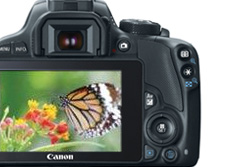

Full HD Movie Mode, your choice of frame rates
The EOS Rebel SL1 makes it easy to capture true professional-quality video. Choose from full 1920 x 1080 HD video at 30 fps, or record at 24 fps for a more cinematic look. Or, switch to standard 1,280 x 720 HD at 60 fps for super-smooth action. You can even shoot PAL video at rates of 50 and 25 fps for use outside the US.
This content provided and sponsored by Canon
Once you've shot your movies, you can even edit them in-camera. Clip out just the part you want to show, then play them back directly from the camera to your HDTV, via the built-in HDMI connector! (HDMI cable not included, purchase one separately to match the camera and your display device.)
The EOS Rebel SL1 gives you video exposure options ranging from fully automatic to fully manual, including ISO adjustment from 100 all the way to 6,400 (12,800 if ISO expansion is enabled) - your creative vision no longer has to end at sunset. Have as much control as you want, when you want it; professional-level features at an affordable price.
This content provided and sponsored by Canon
Focusing with Movie Servo AF
Canon's Hybrid CMOS auto-focus system enables Movie Servo AF, a breakthrough in AF and subject tracking for movie recording. Phase-detect and contrast-detect AF work together to continuously and precisely track subjects as they move through the frame. With the camera handling focus, you can concentrate on getting the shots you want. The stepper motors in Canon's new STM lenses make continuous AF tracking smooth and quiet. The EOS Rebel SL1 with an STM lens attached meets high standards for SLR moviemaking performance!
This content provided and sponsored by Canon -
Pro-Grade Audio
Professional-grade Audio
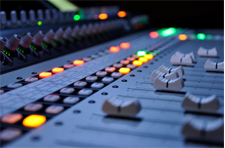

The EOS Rebel SL1 has audio abilities to match its superb video skills. For quick and easy recording, just use the built-in monaural microphone (with wind filter) and let the camera set audio levels automatically. Or, you can take full control, with 64 levels of manual adjustment. There's even a 3.5mm jack for an external microphone, a feature rarely found on entry-level DSLRs.
This content provided and sponsored by Canon -
Video Snapshot
Video Snapshot
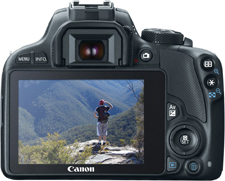
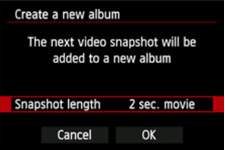
The EOS Rebel SL1's Video Snapshot feature lets you capture short video clips (of 2, 4, or 8 seconds), then combine them automatically into one video file as a snapshot or highlights "album." You don't need to do any editing after shooting, the camera does it all for you! The compiled video is perfect for sharing online, or displaying on an HDTV via the camera's HDMI port. You can also capture and record stills during video shooting, simply by pressing the camera's shutter button. If you want, you can easily change the order or delete clips from an album during playback. Let the Canon EOS Rebel SL1 help you make a "highlights reel" of your life!
This content provided and sponsored by Canon -
Touch Screen
Touch Screen Wide 3.0-inch Clear View LCD

Using capacitive touch screen technology similar to today's popular mobile devices, the EOS Rebel SL1's gorgeous LCD monitor is touch-sensitive, delivering intuitive operation with ease. Two-finger touch gestures can be used for zooming or changing images. Menu and quick control settings can be accessed, and focus point and shutter release can be activated with the touch of a fingertip using Touch AF. Displaying fine detail (at approximately 1.04 million dots), the camera's Touch Screen Wide 3.0-inch Clear View LCD monitor II is perfect for composing and reviewing images. Thanks to a new, solid construction between the monitor's resin-coated cover and the liquid crystal display, reflections are minimized, and the display can be viewed, without glare, from any number of angles. The LCD's surface is treated with a smudge-resistant coating to minimize fingerprints and maintain a bright, clear image display.
This content provided and sponsored by Canon -
Amazing Effects
Amazing Effects for Dramatic and Gorgeous Results

The EOS Rebel SL1 features Scene Intelligent Auto mode, which taps a number of Canon technologies to deliver the best possible exposure automatically. Combining Picture Style Auto, Automatic Lighting Optimizer, Automatic White Balance, Autofocus, and Automatic Exposure, Scene Intelligent Auto mode analyzes the image, accounting for faces, colors, brightness, moving objects, contrast, and even whether the camera is handheld or on a tripod, and then chooses the exposure and enhancements that bring out the best in any scene or situation. You don't have to be an expert or puzzle over camera settings to get great photos: Scene Intelligent Auto mode simplifies DSLR image capture, so you can concentrate on composing your images rather than worrying about complex camera controls. Unleash your imagination!
This content provided and sponsored by Canon
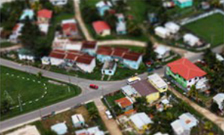
With the Canon EOS Rebel SL1, your creative options don't end with exposure and white balance. Adding to the fun and creative possibilities available, the camera offers seven different creative filters for still images: Art Bold Effect, Water Painting Effect, Miniature Effect, Fisheye Effect, Grainy B/W, Soft Focus and Toy Camera Effect. Each effect can be applied in three different levels (low, standard and strong), and can be easily previewed on the LCD panel during Live View shooting. With the live preview you'll get the shot you want on the first take, rather than guessing and trying multiple times. The EOS Rebel SL1 also features the new Miniature Effect for Movies, an effect previously available only for still images. You will be amazed and delighted by the artistry that these creative filters will allow you to create!
This content provided and sponsored by Canon -
Learn more about
the Canon EOS Rebel SL1 This content provided and sponsored by Canon
Canon SL1 Review
by Dan Havlik, Mike Tomkins, William Brawley and Zig Weidelich
Preview posted: 03/21/2013
Review finalized: 07/23/2013
Field Test by Eamon Hickey
Posted: 07/23/2013
We were told the "SL" in the 18-megapixel Canon SL1 consumer DSLR stood for "super lightweight." And that it certainly is. The new Lilliputian EOS Rebel SL1 feels as light as many mirrorless cameras -- and nearly as small -- especially with a Canon EF 40mm f/2.8 STM pancake lens attached to the front of it. Canon touts the camera as "the world's smallest and lightest DSLR."
Clearly, the burgeoning mirrorless camera market is what Canon is aiming to take on with the fully mirrored SL1. While Canon already has its own compact system camera, the EOS M, this mirrorless model doesn't stack up against many DSLRs in terms of still photography skills. With the Rebel SL1, Canon has attempted to offer the best of both worlds: a compact camera that's small and light enough to take with you anywhere, combined with the performance and high image quality of a DSLR.
Design and build. Though the Canon SL1 is a very small and light camera, its design and build mimic Canon's other DSLRs. Consequently, it's comfortable and ergonomic to use, even for photographers with larger hands. The Rebel SL1 is approximately 25% smaller and 28% lighter than the Canon Rebel T5i -- which was introduced at the same time -- and the T4i before it, with the SL1 measuring 4.6 (w) x 3.6 (h) x 2.7 (d) inches (117 x 91 x 69 mm) and weighing just under 14.4 ounces (407g), with the battery and SD memory card installed (but not the kit lens).
Despite the Rebel SL1's small size, the textured hand grip fits snugly in your hand and the surprisingly large shutter button beckons you to press it. Canon's kept the same 3-inch LCD touchscreen monitor as one on the T5i/T4i, offering 720 x 480 pixel resolution (1,040,000 dots). It's fixed to the rear of the camera, however, and doesn't offer any vari-angle or side-swiveling capabilities.
Sensor and performance. Like the Canon T5i (and the T4i before it), the Rebel SL1 employs an 18-megapixel, APS-C CMOS sensor. The SL1's ISO range is 100 to 12,800 (expandable to 25,600 in H mode) and it boasts low-light capabilities that rival the Canon T4i's, which were quite good.
The Canon SL1 uses a DIGIC 5 image processor, but can shoot just four frames per second in continuous shooting mode, compared to five fps on the T5i/T4i. That four fps burst mode, however, is fairly typical for entry-level DSLRs. It's definitely fast enough to capture candid moments and even some amateur sports. In terms of overall operational speed, the SL1 is peppy and takes advantage of a fairly decent 9-point autofocus system, but with just the center point being a cross-type point. (All nine AF points on the T5i/T4i are cross-type points.)
Expanded AF area. Speaking of the SL1's autofocus capabilities, though it's smaller than the T5i/T4i, its Hybrid CMOS AF II system features an AF area that uses approximately 80% of the width and height of the Live View display. That's a huge difference compared to the AF area of the T5i/T4i, which takes up just 38% of the width and 26% of the height of the Live View display.
This difference translates to improved Live View and movie mode focusing -- especially when the subject is not centered -- and gives photographers more flexibility when composing shots.
Creative features. The Canon SL1 is aimed at novice and beginning photographers, so it comes loaded with plenty of preset creative functions. In particular, the camera boasts a Scene Intelligent Auto Mode, which detects faces, colors, brightness, movement and a whole bunch of other factors, and automatically picks an appropriate exposure mode.
Other creative tools include an Effect Shot mode, which automatically produces two different photos, one with a creative filter and the other without. The Rebel SL1's seven creative filters include Art Bold, Water Painting, Grainy Black and White, Soft Focus, Toy Camera, Fish-Eye and Miniature. As with the T5i, creative filters and the background-blur simulation effect can be shown in real time on the rear LCD during Live View shooting. Other new special scene modes include Kids, Food and Candlelight, providing beginners and even more advanced users with a wide variety of camera effects that not only help do the work for you, but add drama without post processing.
New kit lens. The Rebel SL1 uses an EF-mount that, like other Canon APS-C DSLRs, is also compatible with EF-S lenses. It's available in a kit with Canon's EF-S 18-55mm f/3.5-5.6 IS STM lens, which focuses quickly and quietly, and is pretty sharp for a kit lens. This lens is optimized for Canon's Hybrid CMOS AF II system on the SL1. Together the combination is effective, particularly for shooting video, tamping down any buzz from the focusing motor so you can capture HD clips with only the sounds of a scene being recorded. The 18-55mm STM lens offers four stops of image stabilization. (It's also available separately for a list price of US$250.)
Summary. By creating such a small and light -- yet highly usable -- camera with the EOS Rebel SL1, Canon has added an interesting wrinkle to the DSLR landscape. For photographers who might have been intrigued by small, mirrorless CSCs, the Canon SL1 offers a strong alternative. As it stands, the Rebel SL1 comes in just one color scheme: basic black. It currently retails at US$750 kitted with the EF-S 18-55mm f/3.5-5.6 IS STM lens, while the body-only version costs US$650. At just a $100 premium, the kit lens is a tremendous value (it's sold separately for US$250). The svelte, EF 40mm f/2.8 STM pancake lens, which retails for US$150, would be a solid addition to an SL1 system -- especially since it enhances the camera's compactness.
Canon SL1 Field Test
DSLR performance and IQ in a very compact and lightweight body
Size and handling. The first thing I noticed after unpacking the Canon Rebel SL1 was its weight -- it really is surprisingly featherweight for a DSLR. It's also, of course, uniquely compact for a DSLR, but that difference didn't seem as striking to me. I'm sure that's partly because my test camera came with the EF-S 18-55mm f/3.5-5.6 IS STM kit lens, which is fairly light but not particularly small in stature. But it's also because the SL1 is noticeably thicker than the mirrorless cameras I've used; the camera has to make room for its mirror.
Canon SL1 Technical Insights
Let's take a closer look
Processor. Output from the image sensor is handled by Canon's DIGIC 5 image processor, which was first introduced to the Rebel series in the summer of 2012 with the T4i. It's said to be five times faster than the previous-generation DIGIC 4 chip.
Burst. Although it uses essentially the same processor and sensor pairing as does the Canon T5i, the Canon Rebel SL1 extracts a little less performance. Burst shooting is limited to a manufacturer-rated 4 frames per second in high-speed continuous mode, with focus fixed from the first frame. By way of comparison, its sibling manages 5 fps under the same conditions, as did the Rebel T4i.
Canon SL1 Image Quality Comparison
See how the SL1's image quality compares to rivals
Note that these images are best quality JPEGs straight out of the camera, at default settings including noise reduction. Each camera was shot with one of our very sharp reference prime lenses.
The SL1 and T5i are very similarly spec'd with the same or very similar 18MP APS-C CMOS sensor and DIGIC 5 image processor. As you might expect, the images look very similar to each other.
The D3200 features a 24MP APS-C sensor, so the crops looks slightly different in size and quality. The mosaic crops look very similar between the two, but the SL1 seems to produce sharper fine details. The D3200, however, does noticeably better with the red fabric crop compared to the SL1.
Canon SL1 Print Quality
But how does it look on paper?
The Canon Rebel SL1 uses an 18-megapixel APS-C sensor that's very similar to the one housed inside the Canon T4i & T5i, and produces excellent results for large prints at low ISO levels, all the way up to wall-mountable 30 x 40 inch prints at ISO 100 and 200. Additionally, this camera did surprisingly well in handling noise and grain at higher ISO levels. It wasn't until we got to ISO 6400 and looked very closely at the shadow areas that we began to see noise as well as noticeable degradation in fine detail. Once we get up to ISO 12,800, things start to look a little bleak, although we still thought a 4 x 6 inch print looked acceptable. At ISO 25,600, the lack of fine detail and high ISO noise levels made it difficult for us to call any size acceptable. All in all, a solid performer from Canon with its micro-sized DSLR.
Canon SL1 Conclusion
The smallest DSLR we've ever reviewed still packs a punch
In many ways, the Canon SL1 provides the best of both worlds, pairing the compact, lightweight body of a mirrorless camera and the performance and image quality of a DSLR. You could almost call it a miniaturized version of Canon's Rebel T4i/T5i DSLRs. And that's a good thing; both standard-size interchangeable lens cameras are solid, full-featured consumer models. It's somewhat amazing that Canon can pack so much DSLR into a tiny body.
However, the SL1 does have one important advantage over its bigger siblings -- its new Hybrid CMOS II AF system for shooting in Live View and Movie modes. The previous version of the technology proved to be fairly sluggish in the T4i, but we were relatively impressed with the improved AF speed of Rebel SL1. What's more, the Hybrid CMOS II AF of the SL1 uses a whopping 80% of both the width and height of the LCD monitor, offering a lot more framing and shooting flexibility than the T4i/T5i.
The image quality of the Canon SL1 is almost identical to that of the T4i/T5i; if you look at the comparison crops against the T5i (the replacement for the T4i that was introduced at the same time as the SL1), it's outright uncanny. Photos taken with the SL1 at low ISOs in particular are excellent, but there is noticeable drop-off as ISO rises above 1600 -- the Canon Rebels could still stand some IQ and processing improvements to make high-ISO results more competitive. The SL1 also doesn't exhibit the dynamic range we've seen recently from other consumer DSLRs in its class.
In the Box
The Canon EOS Rebel SL1 ships with the following items in the box:
- Canon SL1 DSLR camera body
- EF-S 18-55mm f/3.5-5.6 IS STM lens (if in a kit)
- Eye cup
- Lithium-ion battery pack LP-E12
- Battery charger LC-E12
- Wide camera strap EW-300D
- USB interface cable IFC-130U
- EOS Digital Solution disc and software instruction manual CD
- Camera instruction manual
Recommended Accessories
- Extra battery pack (LP-E12) for extended outings
- Large capacity SDHC/SDXC memory card. These days, 16GB is a good trade-off between cost and capacity for a consumer DSLR, but if you plan to capture HD movie clips or shoot in RAW format, look for larger cards with Class 6 or faster ratings.
- Additional lenses, especially the EF 40mm f/2.8 STM
- AC adapter kit ACK-E15
- Mini-HDMI cable and/or AV cable
- Wireless remote control RC-6
- Canon EX-series Speedlite external flash
- Mid-size camera bag



Follow Imaging Resource